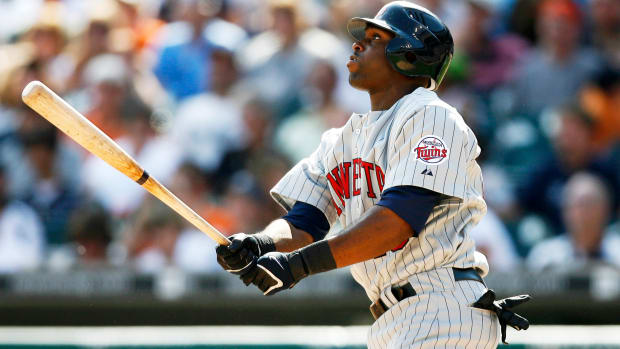Torii Hunter’s Hall of Fame Case Is Stronger Than You’d Think

Torii Hunter’s mentor and center field predecessor with the Twins was Kirby Puckett. The player who eventually pushed Hunter to the corner outfield for good was Mike Trout. One is in the Hall of Fame, and the other is sure to be enshrined at the soonest possible moment. Whether Hunter gets the call to join them is another question entirely.
Though Hunter didn’t immediately follow Puckett as Minnesota’s perennial Gold Glove center fielder, the pair were the defining defensive stars for their respective eras. Puckett won six Gold Gloves from 1986 to ’92; Hunter won nine straight from 2001 to ’09. Over the past 57 years, the Twins have made the playoffs 13 times. They have not won a postseason game during that span without either Puckett or Hunter on the roster.
Hunter made brief big-league appearances in 1997 and ’98 before sticking for good in ’99. Over the next two seasons, he started a combined 187 games in center field for a pair of last-place Twins teams. His bat was slow to acclimate, but he was a dynamic defender and had loads of potential. He soon became the face of a talented young core of position players—a group that included Jacque Jones, Corey Koskie, Cristian Guzmán, A.J. Pierzynski and David Ortiz—that would eventually lead to Minnesota’s resurgence.
In 2001, Hunter hit 27 home runs with a 102 OPS+ across 148 games, earning his first Gold Glove award in the process. The Twins finished above .500 for the first time in nine years, and Hunter was on his way to becoming one of the league’s preeminent young stars. His coming out party came the following season at the All-Star Game in Milwaukee, when he made one of the greatest catches in Midsummer Classic history.
Hunter’s ascension into an All-Star caliber player brought with it a Twins revival. Minnesota won the American League Central four times from 2002 to ‘06, a run that peaked with a trip to the ALCS in ‘02. That stretch was bolstered by the arrival of a new batch of young stars in Johan Santana, Joe Mauer and Justin Morneau. Hunter’s 11-year run with the Twins came to a close when he opted to sign with the Angels for five years and $90 million after the ’07 season.
Hunter continued to thrive in Anaheim, helping guide the franchise to back-to-back division titles from 2008 to ‘09 and a trip to the ‘09 ALCS. His 122 OPS+ with the Halos was his best five-year hitting stretch of his career. He had two more productive seasons with the Tigers before wrapping things up with a swan song in Minnesota for the ‘15 campaign.
Hunter’s jaw-dropping defense and megawatt smile would be his hallmarks for his entire career. But his bat was certainly more than good enough, too. From 2001 to ‘13, he had an OPS+ above 115 in seven out of 13 years, topping 20 home runs 10 times. Hunter made five All-Star appearances during that run, and received MVP votes five times throughout his career (peaking with a sixth-place finish in ‘02).
Defensive metrics being what they are, it’s difficult to measure the precise moment when Hunter ceased being an all-world center fielder. It likely occurred before Trout’s debut in 2011—Hunter had already spent about a third of his time in right field the year prior when the team called up Peter Bourjos—yet his bat continued to improve in his mid-30s. He didn’t win his first Silver Slugger award until his age-33 season, and his second and final one came when he was 37. His OPS+ in his 30s (117) was actually better than it was during his 20s (100)—an impressive feat for someone whose reputation was staked to his defensive wizardry.
It’s that ability to adapt that’s perhaps Hunter’s most impressive quality. It certainly was the key to his longevity—hyper-athletic, glove-first players stationed up the middle need another aspect of their game to rely upon when their speed and defensive prowess begin to wane. Andruw Jones, for example, had a much higher career peak than Hunter. But his production fell off a cliff in his 30s, making Jones’s final career tallies a good contemporary comp for Hunter.

Add up both halves of both players' careers, and you get perhaps a much closer comparison than you might have originally thought. That’s good news for Hunter, who is currently pacing below the 5% threshold needed to remain on the ballot next year (courtesy of Hall of Fame voting tracker Ryan Thibodaux). Jones, meanwhile, is floating just below the 70% mark in his sixth year on the ballot after receiving just 5.7% in his first year. Based on JAWS, Jones ranks 11th among center fielders while Hunter is 36th, though the large difference here can be attributed to Jones’s absurd seven-year peak (46.4 WAR).
By more traditional metrics, though, Hunter comes out more favorably, in large part due to his career lasting 19 seasons with relatively steady production. Hunter is one of 15 players in MLB history to record at least 350 home runs, 150 stolen bases, 450 doubles and 2,400 hits. Of that group, 10 of them are in the Hall. The non-HOF members, along with Hunter, are Barry Bonds, Alex Rodriguez, Gary Sheffield and Carlos Beltrán.
In a way, Hunter’s career offers easily digestible symmetry: He was an excellent defender and a mediocre hitter during his first half, and a strong hitter yet so-so defender in the second half. His evaluation for the Hall is compelling in the sense that it’s a good litmus test for how voters weigh traditional counting stats and subjective awards for defense that don’t always hold up under modern evaluations.
Given the current public voting returns, it’s unlikely Hunter’s accomplishments will culminate in a Hall of Fame bid. He’s going to need a strong finish this year just to see his name on the 2024 ballot. Even if he does, the road to Cooperstown appears as if it will be an uphill slog.
